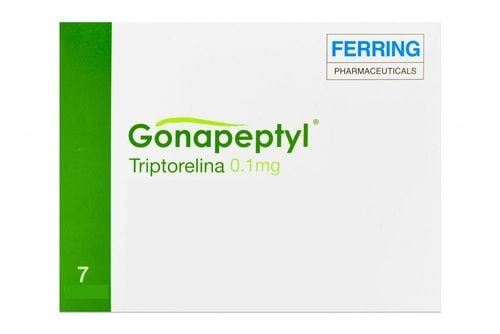This is an automatically translated article.
Prolapse is normal vaginal bleeding during the recovery of the uterus after delivery. At first, the discharge will look like a heavy period, but after a few days, the amount will gradually decrease. What is normal for a woman to have a menstrual period, how to know if the bleeding is over or how long it will take to get her period will help a woman be confident on her motherhood journey.1. What is translation?
The discharge is the vaginal discharge during the postpartum period. The composition of the discharge includes blood, tissue shed from the lining of the uterus, and mucus as a very normal part of the postpartum period. When the placenta separates from the uterus after birth, the blood vessels that open in the local area will begin to bleed into the uterine cavity. After the placenta is removed from the uterine wall, the uterine muscles continue to contract to close the blood vessels, greatly reducing bleeding. The contractions also help shed the remaining uterine lining that supported the baby during pregnancy and return the uterus to its normal size soon.Immediately after delivery, the obstetrician or midwife can massage the uterus and infuse synthetic oxytocin to help the uterus contract quickly and reduce bleeding, preventing postpartum hemorrhage. When breastfeeding, this mechanism will promote the body's natural release of oxytocin, while helping the uterus contract to limit blood loss.
During the first few days after giving birth, the discharge contains a fair amount of blood, so it will be bright red and look like heavy menstrual bleeding. The discharge may be intermittent, in small bursts or even. If a woman moves from a lying down position to a sitting position, once the blood has pooled in the uterus, a woman may notice a little more bleeding. At the same time, discharge can also be observed to be heavier during breastfeeding.
If you have a cesarean section, the woman will still have fluid, which is because the placenta still needs to be removed regardless of how the labor is delivered. Furthermore, the uterus still needs time to shrink to its pre-pregnancy size. However, cesarean delivery will tend to be less quantitative than vaginal delivery.
In rare cases, the uterus does not contract well after delivery, leading to excessive blood loss, a massive amount of fluid, known as postpartum haemorrhage. This is a rare but potentially fatal condition and must be addressed quickly by doctors.
2. How long does it take to clear after birth?
Normal postpartum discharge lasts for a total of 4 to 8 weeks. The heaviest bleeding will last for the first 2-4 days after giving birth. The woman may also feel cramping during this time as the uterus will continue to contract and contract. The amount of discharge will probably be slightly less each day and will decrease over time.About the color of the discharge, about two to four days after giving birth, the discharge is red like menstrual blood but then it will be more watery, diluted, so it is slightly pink. About 10 days after giving birth, a woman may show a small amount of white or yellow-white discharge. At this time, the composition in the fluid is mainly white blood cells and cells from the lining of the uterus.
In the time before the discharge is completely gone, many women will experience some bleeding a few times a day, usually while breastfeeding or while pumping. This is when the uterus contracts in response to the release of oxytocin associated with lactation. This connection helps to flush out the excess blood in the uterus and encourages the possibility of the uterus returning to its pre-pregnancy size.
If a woman starts using progestin-only birth control pills or injects birth control pills, the discharge will become menorrhagia for a month or more and that is completely normal. Similarly, using an IUD and contraceptive implant may cause some normal brown spots during the first few months of use. Accordingly, in these cases, it will be difficult for women to know "how to know if the discharge is finished or not".
3. How to take care of the body during the postpartum period
In the beginning, due to the large amount of discharge, the woman should use thick tampons. At the same time, it is necessary to keep the genital area clean, change the bandage regularly during the day, wear underwear that fits well and absorbs moisture well. These will help minimize the risk of infection in the vagina and the healing uterus.Besides, in the first few days after giving birth, a woman should get into the habit of having to urinate often, even if she doesn't feel the urge to urinate. Immediately after giving birth, the body goes through a lot of changes and repairs; The bladder may become less sensitive than usual.
The amount of discharge will vary from person to person, However, if the bleeding is heavy or accompanied by other symptoms, call your doctor or midwife if:
The discharge is still bright red a week later at birth
Abnormally heavy bleeding (saturated with tampons for two hours in a row or blood clots seen in the discharge). These are signs of late postpartum haemorrhage and need immediate attention.
The amount of fluid has improved or stabilized but suddenly increased again.
In addition, the following symptoms are also signs that a woman needs immediate medical attention:
Pale skin. Lightheadedness, dizziness, or feeling weak. Fast heart beat. Pain and swelling near the vagina. The discharge has a foul odor. In short, postpartum discharge is completely normal. At first, the discharge is bright red and thin, gradually turning pink before completely disappearing after 4 to 8 weeks. When the discharge stops, the woman will be able to ovulate naturally, have her period again and be able to become pregnant. However, if you are breastfeeding, the discharge may still last longer. Therefore, this information will help women know how to know if the discharge is over or not and how long it takes to have a period to take good care of themselves and prevent postpartum infections.
To help customers detect gynecological diseases, Vinmec International General Hospital has a basic gynecological examination and screening package, helping customers to detect early infectious diseases for easy treatment. costly. Screening detects gynecological cancer (cervical cancer) early even when there are no symptoms.
Basic gynecological examination and screening package for female customers, has no age limit and may have the following symptoms:
Abnormal vaginal bleeding Having menstrual problems: irregular menstrual cycle, irregular menstrual cycle Irregular vaginal discharge (smell, different color) Vaginal pain and itching Female clients have several risk factors such as poor personal hygiene, Unsafe sex, abortion,... Female customers have other symptoms such as: Abnormal vaginal discharge, itching, pain in the private area, abnormal vaginal bleeding. Reference source: goodto.com; medicalnewstoday.com; pampers.com; babycentre.co.uk.
Please dial HOTLINE for more information or register for an appointment HERE. Download MyVinmec app to make appointments faster and to manage your bookings easily.













